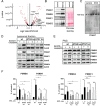Proteaphagy in Mammalian Cells Can Function Independent of ATG5/ATG7
- PMID: 32299840
- PMCID: PMC7338089
- DOI: 10.1074/mcp.RA120.001983
Proteaphagy in Mammalian Cells Can Function Independent of ATG5/ATG7
Abstract
The degradation of intra- and extracellular proteins is essential in all cell types and mediated by two systems, the ubiquitin-proteasome system (UPS) and the autophagy-lysosome pathway. This study investigates the changes in autophagosomal and lysosomal proteomes upon inhibition of proteasomes by bortezomib (BTZ) or MG132. We find an increased abundance of more than 50 proteins in lysosomes of cells in which the proteasome is inhibited. Among those are dihydrofolate reductase (DHFR), β-Catenin and 3-hydroxy-3-methylglutaryl-coenzym-A (HMGCoA)-reductase. Because these proteins are known to be degraded by the proteasome they seem to be compensatorily delivered to the autophagosomal pathway when the proteasome is inactivated. Surprisingly, most of the proteins which show increased amounts in the lysosomes of BTZ or MG132 treated cells are proteasomal subunits. Thus an inactivated, non-functional proteasome is delivered to the autophagic pathway. Native gel electrophoresis shows that the proteasome reaches the lysosome intact and not disassembled. Adaptor proteins, which target proteasomes to autophagy, have been described in Arabidopsis, Saccharomyces and upon starvation in mammalians. However, in cell lines deficient of these proteins or their mammalian orthologues, respectively, the transfer of proteasomes to the lysosome is not impaired. Obviously, these proteins do not play a role as autophagy adaptor proteins in mammalian cells. We can also show that chaperone-mediated autophagy (CMA) does not participate in the proteasome delivery to the lysosomes. In autophagy-related (ATG)-5 and ATG7 deficient cells the delivery of inactivated proteasomes to the autophagic pathway was only partially blocked, indicating the existence of at least two different pathways by which inactivated proteasomes can be delivered to the lysosome in mammalian cells.
Keywords: Proteases; autophagy; lysosome; proteasome; protein degradation; protein turnover; subcellular analysis.
© 2020 Goebel et al.
Conflict of interest statement
The authors declare that they have no conflicts of interest with the contents of this article
Figures







References
-
- Saftig P., and Klumperman J. (2009) Lysosome biogenesis and lysosomal membrane proteins: trafficking meets function. Nat. Rev. Mol. Cell Biol. 10, 623–635 - PubMed
-
- Bento C. F., Renna M., Ghislat G., Puri C., Ashkenazi A., Vicinanza M., Menzies F. M., and Rubinsztein D. C. (2016) Mammalian Autophagy: How Does It Work? Annu. Rev. Biochem. 85, 685–713 - PubMed
Publication types
MeSH terms
Substances
LinkOut - more resources
Full Text Sources
Molecular Biology Databases
Research Materials

